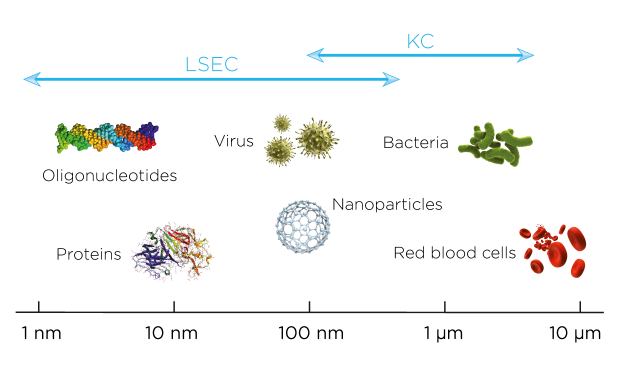
Size matters
As illustrated in the figure, most biopharmaceuticals and nanoparticles (<2-300 nm) are taken up mainly by liver sinusoidal endothelial cells (LSECs). Large particle formulations (generally >2-300 nm) are taken up by Kupffer cells (KCs). These substances only rarely interact with hepatocytes.
Hence, it is crucial to include LSECs in liver uptake, distribution and metabolism assays.
Liver sinusoidal endothelial cells
Liver sinusoidal endothelial cells (LSECs) are very thin cells that line the liver sinusoids and separate blood from the hepatocytes. The blood flow through the sinusoid is slow giving LSECs a perfect condition to eliminate macromolecules from the blood. Representing one of the most actively endocytosing cell types in the body the LSEC is regarded as a professional pinocyte and very efficiently eliminates soluble macromolecules and small particles (colloids) from the blood circulation. In fact, the most important site of elimination of nearly all tested soluble waste macromolecules and nanoparticles injected into animals are the LSECs. The LSECs make up only 3,3 % of the total liver volume, but 21 % of the total number of liver cells.
Kupffer cells
Kupffer cells (KCs) are macrophages located at the lining of the liver sinusoid. They belong to the scavenger cell system in the liver and are professional phagocytes that eliminate large, insoluble particles such as bacteria, cancer cells, activated platelets and aged and damaged red blood cells from the blood circulation. The KCs make up 2,5 % of the total liver volume, and 8,5 % of the total number of liver cells.
Hepatocytes
Hepatocytes, also referred to as liver parenchymal cells, are specialised epithelial cells that are the most abundant type of cell in the liver. The hepatocytes make up more than 90 % of the total liver volume, and 60 - 70 % of the total number of liver cells.
